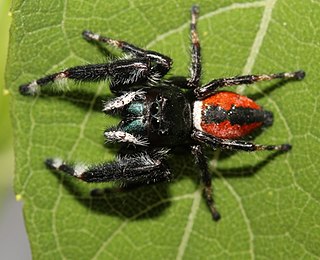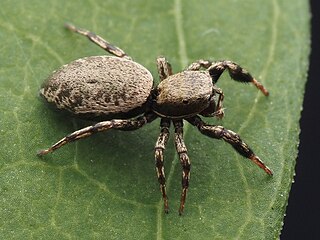
Phidippus is a genus in the family Salticidae. Some of the largest jumping spiders inhabit this genus, and many species are characterized by their brilliant, iridescent green chelicerae. Phidippus is distributed almost exclusively in North America, with the exception of two exported species. As of January 2021, there were about 80 described species in the genus. Species previously described in Phidippus which are found in India and Bangladesh do not belong in this genus.

Phidippus audax, the bold jumper or bold jumping spider, is a common species of spider belonging to the genus Phidippus, a group of jumping spiders easily identified by their large eyes and their iridescent chelicerae. Like all jumping spiders, they have excellent stereoscopic vision that aids them in stalking prey and facilitates visual communication with potential mates during courting. Bold jumping spiders are native to North America and have been introduced to Hawaii, Nicobar Islands, Azores, and the Netherlands. They are typically black with a distinct white triangle on their abdomen.

Phidippus cardinalis is a species of jumping spider. It is commonly called cardinal jumper. It is one of the species of jumping spiders which are mimics of mutillid wasps in the genus Dasymutilla ; several species of these wasps are similar in size and coloration to the spiders, and possess a very painful sting.

Phidippus regius, known commonly as the regal jumper, is a species of jumping spider in eastern North America.

Phidippus johnsoni, the red-backed jumping spider or Johnson jumping spider, is one of the largest and most commonly encountered jumping spiders of western North America. It is not to be confused with the unrelated and highly venomous redback spider.

Phidippus californicus is a species of jumping spider. It is found in the southwestern United States and northern Mexico.

Phidippus mystaceus is a species of jumping spider that is found in North America. Females grow to about 1 centimetre (0.39 in) in body length.

Phidippus pius is a species of jumping spider that is found in Central America and North America. Its range extends from the Eastern United States, west to Arizona, and south to Costa Rica. The color pattern of this species varies. Females are yellow to orange while males are orange to red.

Phidippus Clarus, also known as the Brilliant Jumping Spider, is a species of jumping spider found in old fields throughout eastern North America. It often waits upside down near the top of a plant, which may be useful for detecting prey, and then quickly jumps down before the prey can escape. The spider is one of 60 species in the genus Phidippus, and one of about 5,000 in the Salticidae, a family that accounts for about 10% of all spider species. P. clarus is a predator, mostly consuming insects, other spiders, and other terrestrial arthropods.

Phidippus insignarius is a species of jumping spider in the family Salticidae. It is found in the United States.

Phidippus texanus is a species of jumping spider in the family Salticidae. It is found in the United States and Mexico.

Habronattus orbus is a species of jumping spider in the family Salticidae. It is found in the United States.

Marpissa formosa is a species of jumping spider. It is found in the eastern United States,South West Asia.

Phidippus nikites is a species of jumping spider in the family Salticidae. It is found in the United States and Mexico.

Tutelina harti is a species of jumping spider. It is found in the United States and Canada.

Talavera minuta is a species of jumping spider in the family Salticidae. It is found in Russia, Canada, and the United States.

Chalcoscirtus diminutus is a species of jumping spider in the family Salticidae. It is found in the United States.

Phidippus comatus is a species of jumping spider in the family Salticidae. It is found in North America.

Phidippus apacheanus is a species of jumping spider in the family Salticidae. It is found in the United States, Mexico, and Cuba.

Phidippus pruinosus is a species of jumping spider in the family Salticidae. It was described by arachnologists George and Elizabeth Peckham in 1909. It is found only in the state of Texas in the United States.
























